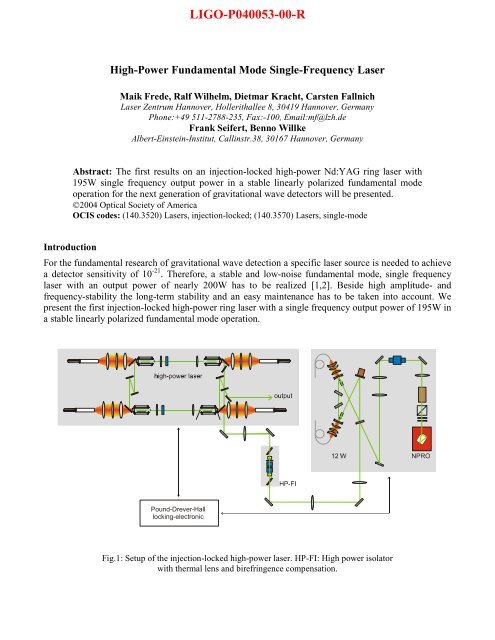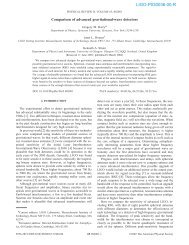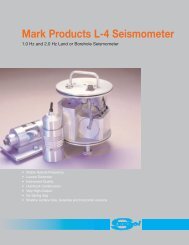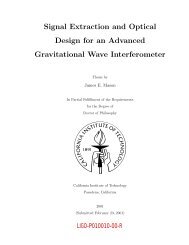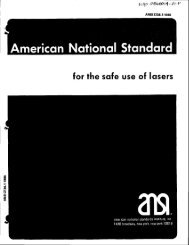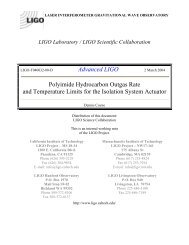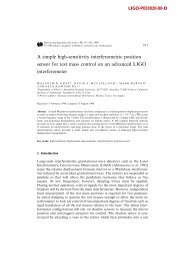High-Power Fundamental Mode Single-Frequency Laser - LIGO
High-Power Fundamental Mode Single-Frequency Laser - LIGO
High-Power Fundamental Mode Single-Frequency Laser - LIGO
You also want an ePaper? Increase the reach of your titles
YUMPU automatically turns print PDFs into web optimized ePapers that Google loves.
<strong>High</strong>-<strong>Power</strong> <strong>Fundamental</strong> <strong>Mode</strong> <strong>Single</strong>-<strong>Frequency</strong> <strong>Laser</strong><br />
Maik Frede, Ralf Wilhelm, Dietmar Kracht, Carsten Fallnich<br />
<strong>Laser</strong> Zentrum Hannover, Hollerithallee 8, 30419 Hannover, Germany<br />
Phone:+49 511-2788-235, Fax:-100, Email:mf@lzh.de<br />
Frank Seifert, Benno Willke<br />
Albert-Einstein-Institut, Callinstr.38, 30167 Hannover, Germany<br />
Abstract: The first results on an injection-locked high-power Nd:YAG ring laser with<br />
195W single frequency output power in a stable linearly polarized fundamental mode<br />
operation for the next generation of gravitational wave detectors will be presented.<br />
©2004 Optical Society of America<br />
OCIS codes: (140.3520) <strong>Laser</strong>s, injection-locked; (140.3570) <strong>Laser</strong>s, single-mode<br />
Introduction<br />
For the fundamental research of gravitational wave detection a specific laser source is needed to achieve<br />
a detector sensitivity of 10 -21 . Therefore, a stable and low-noise fundamental mode, single frequency<br />
laser with an output power of nearly 200W has to be realized [1,2]. Beside high amplitude- and<br />
frequency-stability the long-term stability and an easy maintenance has to be taken into account. We<br />
present the first injection-locked high-power ring laser with a single frequency output power of 195W in<br />
a stable linearly polarized fundamental mode operation.<br />
Pound-Drever-Hall<br />
locking-electronic<br />
<strong>LIGO</strong>-P040053-00-R<br />
Fig.1: Setup of the injection-locked high-power laser. HP-FI: <strong>High</strong> power isolator<br />
with thermal lens and birefringence compensation.
<strong>Laser</strong> concept<br />
To achieve a linearly polarized fundamental mode output power in the range of 200W a high power laser<br />
with four end-pumped Nd:YAG laser rods was developed. To compensate the thermally induced<br />
birefringence each two of the laser rods are combined with a birefringence compensation [3]. To achieve<br />
high long-term stability and an easy maintenance each laser rod is pumped with a fiber bundle of 10<br />
fiber-coupled diodes each delivering up to 30W of pump power. The diodes were operated by nearly<br />
75% of their nominal power to increase the diode lifetime. In case of long-term stability and<br />
maintenance, the derated operation of the diodes enables the compensation of a diode failure or diode<br />
degradation. A pump-light homogenizer was connected to the fiber ends to achieve a homogenous<br />
pump-light distribution [4]. To reduce the maximum temperature and surface stresses at the 40mm long<br />
0.1 at.% doped Nd:YAG rod, two 7mm long undoped end caps were attached [5,6]. Furthermore, a<br />
double pass of the pump light was realized for smoothing the longitudinal temperature distribution. In<br />
order to perform injection-locking for single frequency operation the laser system was used in a ring<br />
resonator configuration. The setup of the whole system is sketched in Figure 1.<br />
To achieve a stable single frequency operation with a locking-range of a few MHz the frequency<br />
stability of a 0.8W single frequency master laser (NPRO) [7] is transferred via an intermediate 12W ring<br />
oscillator [8] to the high-power slave laser. The locking of the high-power laser via the intermediate<br />
stage increases the locking range by a factor of 4 because the locking range is proportional to the square<br />
root of the master to the slave laser power. An active length control system based on the Pound-Drever-<br />
Hall scheme [9] was used to keep the difference between master and slave laser cavity frequencies to a<br />
value within the injection-locking range. A first electronic system stabilized the 12W laser cavity to the<br />
frequency of the NPRO. If these lasers are in a non-locked condition a sawtooth voltage is applied to a<br />
piezo mirror of the 12W laser system. Therefore, the laser cavity length is changed and the cavity is<br />
scanned through her eigenfrequencies, until the cavity length fits to the frequency of the NPRO. If the<br />
frequencies coincide, the injection-locking starts and the laser operates in a unidirectional instead of a<br />
bidirectional mode. In this case a photo-diode at the output port detects twice the output power and the<br />
Pound–Drever–Hall stabilization locks the cavity length. To lock the high-power laser a similar<br />
procedure starts immediately as soon as the first two stages are stably locked. With these locking<br />
electronics a stable single frequency operation and a fast re-lock time was achieved.<br />
Experimental results<br />
With a pump power of nearly 800W the free running high-power laser operates with a linearly polarized<br />
output power of 180W (90W for each direction). The laser runs in a stable fundamental mode operation<br />
which is monitored by a photo diode and an electrical spectrum analyzer. In free running operation and<br />
only one circulating transversal mode, this mode beats with the circulating longitudinal modes and<br />
produces beat signals with a distance of the free spectral range (FSR) of the laser cavity. In our<br />
measurements no higher transversal modes could be detected between the two beat signals of the<br />
fundamental mode. This measurement can also be used to verify the single frequency operation, because<br />
if there is only one circulating longitudinal mode, no beat signals can be detected.<br />
Starting the locking of the system as described above, the laser starts circulating in only one direction<br />
instead of the bidirectional operation. Therefore, the laser output power increased by nearly a factor of<br />
two, see Figure 2. After a few minutes the laser achieved the thermal equilibrium and operates in a<br />
stable single frequency operation. Only external disturbances can disrupt the operation, as seen at the
elock peak. In this operation a linearly polarized fundamental mode output power of 195W was<br />
achieved. This is to the best of our knowledge the highest injection-locked single-frequency output<br />
power with an optical to optical efficiency > 24%.<br />
Output <strong>Power</strong> [W]<br />
200<br />
180<br />
160<br />
140<br />
120<br />
100<br />
injection-locked slave<br />
unlocked high power laser<br />
+ injected 12 W laser<br />
re-lock<br />
80<br />
01:12 01:13 01:15 01:16 01:17 01:19 01:20 01:22<br />
Time [mm:ss]<br />
Fig.2: Locking process of the high power ring laser.<br />
To analyse the locking range the Pound-Drever-Hall error signals have been evaluated, see Figure 3. The<br />
measured locking ranges of 4.4 MHz and 2.9 MHz are below the calculated results of 4.8 and 6.3 MHz<br />
for the intermediate and the high power slave laser, respectively.<br />
PD DC [V]<br />
3,0<br />
2,5<br />
2,0<br />
1,5<br />
1,0<br />
0,5<br />
0,0<br />
-0,5<br />
-1,0<br />
-1,5<br />
intermediate 12 W<br />
high power slave<br />
-0,0005 0,0000 0,0005<br />
Fig.3: Pound-Drever-Hall error signals measured from the intermediate and the high power slave laser<br />
by changing the cavity length near the resonance frequency.<br />
t [s]<br />
1<br />
0<br />
-1<br />
-2<br />
-3<br />
-4
Especially the locking range of the high-power laser has to be improved to guaranty a long and stable<br />
locking. Independent from the locking range it was demonstrated for the first time that a slave laser with<br />
an output power above 100W can be stably coupled to single frequency operation.<br />
The first long term test showed stable locking over 8 hours with only a few re-locks caused by external<br />
disturbances. For these external disturbances like temperature or pressure changes which changed the<br />
cavity length above the piezo range or for some strong mechanical shock to the optical table an autolock<br />
feature was implemented. The dropping output power is detected by the electronic and starts<br />
immediately the re-lock of the system as described above. The re-locking process of the complete<br />
system takes less than 400 ms as shown in Figure 4.<br />
PD DC [V]<br />
0,0<br />
-0,4<br />
-0,8<br />
-1,2<br />
-1,6<br />
-2,0<br />
high power laser<br />
intermediate 12 W<br />
-2,4<br />
-0,4 -0,2 0,0 0,2 0,4<br />
Fig.4: Relock-time of the complete laser system. Measured is the output of the intermediate<br />
and the high-power laser.<br />
t [s]<br />
Conclusion<br />
We presented a high-power ring resonator with four end-pumped laser heads injection-locked via an<br />
intermediate 12W laser to a single frequency NPRO. With this setup 195W linearly polarized, singlefrequency,<br />
fundamental mode output power was demonstrated. This is the first time that injectionlocking<br />
for a high power laser was applied and from our best knowledge the highest injection-locked<br />
single-frequency output power.
Outlook<br />
After optimization of the locking range, in order to achieve less sensitivity to external disturbances, the<br />
system has to be further characterized in respect of beam quality as well as amplitude- and frequencynoise.<br />
Therefore, a mode-analyzer-cavity (MAC) will be used. By scanning the MAC through its free<br />
spectral range, a complete mode spectrum of the laser can be measured and all higher-order modes can<br />
be detected. By locking the MAC to the laser also the frequency stability of the laser can be measured, if<br />
thermal and acoustic coupling to the MAC is avoided. To achieve the amplitude- and frequencystabilization<br />
needed for gravitational wave detection active control loops will be implemented.<br />
References:<br />
[1] <strong>LIGO</strong> II Conceptual Project Book, <strong>LIGO</strong> M990288-A-M (1999)<br />
[2] Advanced <strong>LIGO</strong> homepage: http://www.ligo.caltech.edu/adv<strong>LIGO</strong>/<br />
[3] M.Frede at al., “<strong>High</strong> power fundamental mode Nd:YAG laser with efficient birefringence compensation”,<br />
Optics Express 12, 3581-3589 (2004)<br />
[4] M. Frede et al., "<strong>High</strong>-power single-frequency Nd:YAG laser for gravitational wave detection",<br />
Class.Quantum Grav. 21, 895-901 (2004)<br />
[5] Jan Sulc et al., “Comparison of different composite Nd:YAG rods thermal properties under diode pumping ”<br />
SPIE-Int. Soc. Opt. Eng, 4630, 128-134 (2002)<br />
[6] M. Tsunekane et al., “Analytical and Experimental Studies on the Characteristics of Composite Solid-State<br />
<strong>Laser</strong> Rods in Diode-End-Pumped Geometry ” IEEE, J. of Selected Topics in Quantum Electronics, 3,<br />
9-18 (1997)<br />
[7] T.J Kane et al., “Monolithic, unidirectional single-mode Nd:YAG ring laser,” Opt. Lett. 10, 65-67 (1985)<br />
[8] I. Zawischa et al., “The GEO 600 laser system”, Class. Quantum Grav. 19, 1775-1781 (2002)<br />
[9] Eric D. Black, “An introduction to Pound-Drever-Hall laser frequency stabilization”, Am. J. Phys. 69,<br />
79-87 (2000)


